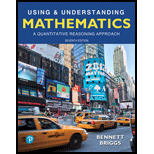
Concept explainers
Personal Consumption. The Bureau of Economic Analysis estimates that in 2015, personal consumption expenditures of Americans totaled $12.3 trillion. The major categories of these expenditures were durable goods ($1.36 trillion; for example, cars, furniture, recreational equipment), nondurable goods ($2.66 trillion; for example, food, clothing, fuel), and services ($8.3 trillion; for example, health care, education, transportation).
a. What was the approximate annual per capita spending on personal consumption? Assume a population of 321 million.
b. What was the approximate daily per capita spending on personal consumption?
c. On average, about what percentage of personal consumption spending was devoted to services? Is this figure consistent with your own spending?
d. Spending on health care was estimated to be $2.1 trillion. About what percentage of all personal consumption spending was devoted to health care?
e. In 2000, the total spending on personal consumption was $6.8 trillion, while health care spending was $918 billion. Compare the percentage increase in total spending and health care spending between 2000 and 2015.
Want to see the full answer?
Check out a sample textbook solution
Chapter 3 Solutions
Using & Understanding Mathematics: A Quantitative Reasoning Approach (7th Edition)
- Solve the equation. Write the smaller answer first. 2 (x-6)² = 36 x = Α x = Previous Page Next Pagearrow_forwardWrite a quadratic equation in factored form that has solutions of x = 2 and x = = -3/5 ○ a) (x-2)(5x + 3) = 0 ○ b) (x + 2)(3x-5) = 0 O c) (x + 2)(5x -3) = 0 ○ d) (x-2)(3x + 5) = 0arrow_forwardA vacant lot is being converted into a community garden. The garden and a walkway around its perimeter have an area of 690 square feet. Find the width of the walkway (x) if the garden measures 14 feet wide by 18 feet long. Write answer to 2 decimal places. (Write the number without units). Hint: add 2x to each of the garden dimensions of 14 x 18 feet to get the total area for the length multiplied by width.arrow_forward
- Solve the rational equation 14 1 + x-6 x x-7 x-7 ○ a) x = 1, x = 8 ○ b) x = 1 ○ c) x = 7 ○ d) x = 1, x = 7arrow_forwardSolve the absolute inequality | x + 5 > 3 ○ a) (-∞, -8] U[-2, ∞0) ☐ b) (-8, -2) c) (-2, ∞0) ○ d) (-∞, - 8) U(-2, ∞0)arrow_forward1) Listen Describe the error in the problem X 3 X x 3 - 2 = 25x = 0 25x 25 x = ±5arrow_forward
 Holt Mcdougal Larson Pre-algebra: Student Edition...AlgebraISBN:9780547587776Author:HOLT MCDOUGALPublisher:HOLT MCDOUGAL
Holt Mcdougal Larson Pre-algebra: Student Edition...AlgebraISBN:9780547587776Author:HOLT MCDOUGALPublisher:HOLT MCDOUGAL
